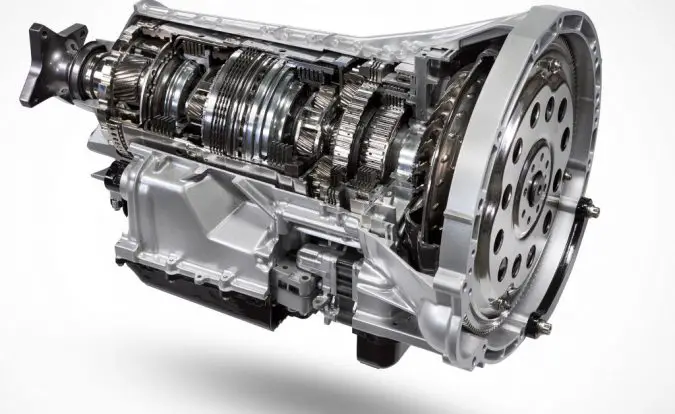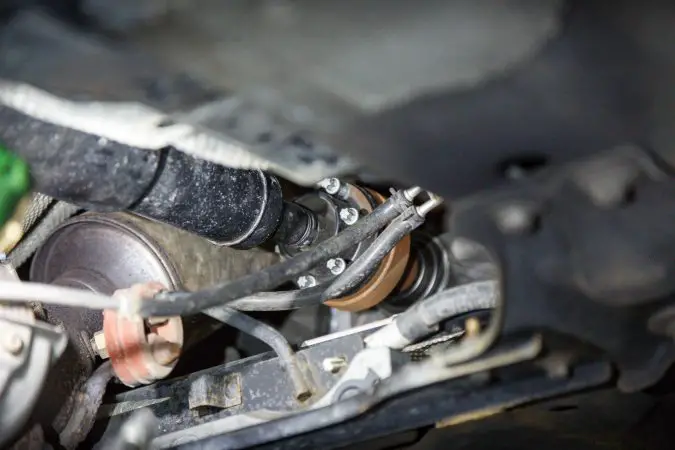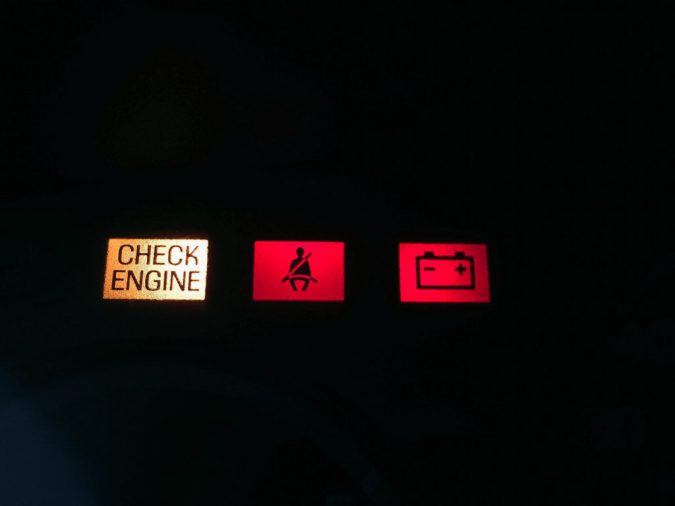The transmission is as important to any car as muscles are in your body. While your fleshy muscles transfer energy to the many organs and limbs connected to it, the gearbox makes sure it can control your engine’s power. From there, the mass of force can be managed carefully to each of your car’s four wheels. However, as much as you need to trust and rely on your gearbox to work all the time, problems do appear. One of them manifests into questions around transmission leak repair costs.
It’s disheartening to see any puddle pool up from beneath your car. In the case of gearboxes, it ought to be transmission fluid that’s seeping into the ground below. But why is my gearbox leaking, and what can I do to fix it? More importantly, how much is all this going to cost? Well, our guide on transmission leak repair costs has uncovered that the price can vary from as little as tens of dollars for minor repairs. Or, it can ramp up quickly to thousands of dollars if you need a new gearbox.
What Do You Need To Know About Transmission Fluid?
Before we get into discussing transmission leak repair costs, we should first understand more about the liquids that are leaking in the first place. So, what is transmission fluid and what does it do? Quite simply, it works for your gearbox in the same fashion that motor oil does for your engine. Your car’s gearbox has many moving parts working in tandem. Consequently, there’s a lot of friction and heat being generated as the transmission continually changes from one gear to the next.
To mitigate this effect, and to preserve the performance, efficiency, and longevity of the gearbox, we have transmission fluid. It has two primary functions. Firstly, it behaves as lubrication to smoothen out any and all friction between those moving componentry. Secondly, it’s the transmission’s source of coolant to keep the temperature in check. This aids in cooling down the hot gearbox, as many technicians can agree that overheating (which is proven by the “AT oil temp” light in a Subaru) is the No. 1 cause of faulty transmissions.
What’s Causing Your Car’s Transmission To Leak?
So far, we’ve pinned down that the only possible liquid to be concerned about with transmission leak repair costs is transmission fluid. This reddish – or a darker maroon or reddish-brown if it’s a bit old – liquid has many roles to play in the everyday workings of your gearbox. Without it, it’s safe to say that we can expect poor performance and unreliability (read: not working properly) when you need it to. On top of that, we can also see your transmission tearing itself into pieces and failing over time.
Thus, transmission fluid is absolutely vital in every car. However, what’s causing your gearbox to be leaking transmission fluid anyways? For this, we should look carefully at all the parts within your gearbox that could turn into points of failure. Knowing the exact causes – i.e. which component has failed – is key in determining how costly the mission leak repair costs will be. So, here are some of the core units within your car’s transmission that could fail, and leak transmission fluid…
1. Faulty Transmission Fluid Pan Gasket (And Drain Plug Gasket)
As with motor oil, the transmission fluid has a ‘pan’ that serves as a large pool or reservoir to safely store the liquids. By far the most common cause of leaking are faults along the transmission fluid pan itself. One of them would be the gaskets that surround the pan, which is placed between the gearbox and the pan. These seals and gaskets are what prevent transmission fluid from seeping out. This is while it continually flows in and out of the pan, to the gearbox.
Over time, however, the gaskets – that are often made from silicone – will start to exhibit wear. It can sometimes be caused by technicians improperly installing the gasket following service, or due to natural aging. A worn gasket will sooner rather than later start leaking fluids. Although it might be small at first, the leaks will eventually get bigger. The leakage will continue to worsen until the gasket and seals can be replaced, which should be done promptly.
Another possible fault waiting to happen on the pan is the gaskets around the drain plugs. This is where a mechanic would start to drain away and flush transmission fluids. The drain plug gasket should be inspected every time the plug is removed to make sure it’s still in good condition. The gasket normally comes off with the plug. Once again, poor care during servicing can lead to the gaskets being installed or inspected improperly. This can lead to it wearing out and leaking.
2. Damaged Transmission Fluid Cooling Lines (Or The Cooling System)
As we noted earlier, your car’s transmission fluid plays a role as both a lubricant and a coolant. With the latter, your gearbox has cooling lines. These are two sets of often rubber – although it could be metal – tubing. One carries hot transmission fluid out of the transmission, while the other flows back cool fluids back into the gearbox. There is a cooling pump in there to help circulate the transmission fluid. The ‘hot’ tube (or line) is attached to your car’s radiator, from where it will be cooled.
Nevertheless, the cooling lines can also wear over time. If they’re made of rubber, they can harden and crack once exposed to a lot of heat after a long period of time. The cooling lines can show signs of it bulging, forming indentations, or cracking into tiny holes. If it’s made from metal, they too can start rusting. Another potential fault with your transmission’s cooling system includes loose clamps that aren’t able to hold the tubing in place.
3. Defective Torque Pump (Or Sometimes Called The Torque Converter)
Speaking of cooling, that pump is also a potential cause for concern, and something worth checking over for transmission leak repair costs. Otherwise referred to as the ‘torque pump‘, this is the part tasked with exerting pressure to help circulate the flow of transmission fluid around your gearbox. This can include moving transmission fluid in and out of the gearbox for lubrication. Alternatively, its job could involve recirculating hot and cold fluids to cool down your transmission.
As it undergoes a lot of strain, the torque pump can wear out and fail. At this point, it may not be able to put enough pressure for the transmission fluid to flow at a sufficient velocity. Worse, the transmission fluid might stop flowing entirely, which can cause a lot more problems down the line. The pump can crack if not cared for, serviced, or replaced in a timely manner. When this happens, transmission fluid can start leaking from there.
4. Broken Gearbox Input Or Output Shaft Seals
In your transmission, there is something called ‘input’ and ‘output’ shafts. They’re integral to the workings of your gearbox. The input shaft is connected to the engine. Your engine’s power – through the flywheel’s rotational motion – is transmitted to the gearbox through the input shaft. You can now select the gearing ratio (or gears) to moderate the amount of the engine’s power that gets sent to the wheels. Once you’ve picked the right gear, that power is then sent to the output shaft.
This then connects the gearbox to the wheels, thus delivering all that energy to the ground. Both the input and output shafts are moving components, and they too have seals. These are among the most common ones to fail, as the rubberized seals on the input and output shafts are constantly exposed to the elements. As the rubber gradually wears out, it can start forming small cracks, from where transmission fluid can leak through. If not replaced, the cracks along the seals will get worse.
5. Miscellaneous Other Faults
Aside from all these more noticeable defects, there are other flaws in and around your transmission from where fluids can start seeping through. The first that we can discuss is going back to that fluid pan from earlier. While the gaskets and seals around the transmission fluid pan (or reservoir) are the most usual ones to fail, the pan itself can become damaged. Even though it’s made from steel, and is generally made to last for a very long time.
However, it does sit exposed in the undercarriage of your car. Hence, it could be subject to corrosion. Or, you might’ve had an accident, or had rocks pelting constantly pelting the pan. It could form holes for fluids to leak through. Beyond that, we can once again take a peek at the seals. Besides the ones that we’ve mentioned already, your car’s transmission has countless other seals to keep the fluids in, including the shifter housing seal, plug seal, tail housing seal, output shaft seal, and so on.
These rubberized seals will harden and crack over time, mainly due to their exposure to heat. Your car’s gearbox has other parts that might spring a leak, too. For example, there’s the valve body, which supplies the necessary pressure to move the transmission’s many gears, or the solenoid that works to control the gear shifts. Should either of these parts wear out or break entirely, then transmission fluid could start leaking from there.
What Are The Symptoms Of Transmission Leaking That You Should Look Out For?
Of course, the best way to notice that your car has a leaky transmission is to see a reddish – or dark red-brownish – puddle underneath your car. But there are other ways of knowing when it’s time to consider thinking about transmission leak repair costs. The first would be the performance of the gearbox. You can immediately start noticing signs that something’s amiss when your gearbox displays any one of these odd behaviors:
- You’ll hear odd noises during gear changes, like a grinding, crunching, clunking, bumping, or squealing sound.
- Your car will have difficulty changing gears, such as shifting hard, undergoing gear slippage, being reluctant to shift by holding onto gears, and so on.
- You’ll notice a delay in acceleration and sluggishness in general while on the move.
- You might feel a lot of unwelcome vibrations during gear changes, likely caused by transmission slipping.
Apart from the gearbox’s behaviour, there are a few other signs that you could look out for to see if your gearbox is leaking its transmission fluids. Some cars might inform that you’re running on low levels of transmission fluid with a warning light. Or, you can check the reservoir (within the engine bay) yourself to see if it does, or doesn’t have sufficient fluids.
If the transmission fluids are leaking, your gearbox will almost certainly overheat. At which point, you can smell around if there are any burnt or heaty odors, especially after driving it for a while. But if you couldn’t smell it, you might be able to feel a lot of heat permeating into the cabin. You could feel the heat rising through the floor, where the transfer case might be.
How Much Are The Transmission Leak Repair Costs For Your Car?
So far then, we’ve learned that there are a lot of places that could be the source of transmission fluid leaking. What this could also mean that the prices for patching up your leaky gearbox will also vary wildly depending on what needs to be done. As we mentioned in the beginning, the costs could start from as little as around $50 for minor repairs. However, they can quickly escalate to thousands of dollars if you’ve not been diligent or prudent enough at keeping on top of the problem.
Should it require complex replacements of parts, and long hours of labor to work on your car, you can expect the bills to multiply exponentially. Another crucial variable to factor in while calculating the transmission leak repair costs would be the make and model of your car. The more performant, high-end, or heavy-duty your vehicle is, it may have a more complicated gearbox to match. Taking that into consideration, the costs will start ramping up, too.
Here is a more precise average breakdown – for most cars today – of how much the true transmission leak repair costs look like…
Fluid Pan Gasket – $150 to $200
You can reseal the oil pan gaskets with brand new RTV or silicone. For some cars, you should look out for vehicle-specific RTV or silicone sealants to patch up the gaskets. However, most standard RTV can be had for less than $20. At this point, you’re also recommended to replace the transmission fluid in your car to prevent any contaminants from seeping into the gearbox.
A bottle of new fluids will net you another $20 to $50, and add a bit more on top for the flushing of the old fluids. As you replace the fluids, you should swap out the transmission fluid filter, as well. This would keep out any debris from contaminating the fluid. The filters can range anywhere from $10 to $50.
Fluid Pan Drain Plug Gasket – $250
A drain plug gasket is perhaps the cheapest component there is within your transmission. You can find one for less or around $5. However, while doing so, you’re recommended to also replace the transmission fluid ($20 to $50 for a bottle). Plus, you’ll need to factor in a full flush of the old fluids as with before, adding another $100 or more to the bill.
Cooling Line – $100 to $500
Now getting to the more expensive repairs, your gearbox’s cooling lines do vary a lot in price. There are numerous factors at play, mainly revolving around the material and construction of the cooling lines or tubing you have in your car. If it’s rubber, you can find a new set of cooling tubes for around $20 to $50. If it’s a metal line, it can cost you more, in the neighborhood of $250 or more.
That’s before accounting for labor, mind you. If you think you have some DIY skills, you can instead opt to do the repairs from home, with dedicated cooling line repair kits. You can buy these for around $80 to over $200. However, they really are designed more for professional use. For regular folks, you can expect a full repair for cooling lines to be between $100 to $500.
Input/Output Shaft Seals – $200 to $400
Continuing with a familiar theme, seals aren’t expensive, even for important components like the gearbox’s input and output shafts. You can find a new sealant for around $20. However, resealing them is a labor-intensive process that often involves removing the entire transmission out of the way first. This takes a lot of time and effort to complete.
Moreover, you’ll possibly have to factor in a full flush and replacement of the transmission fluids after the seals have been replaced. Once again, that’s $20-$50 for a bottle of new fluids and another $100 for a flush. Altogether, and the price is mostly attributed to labor costs, you can expect a final bill for seals to be around $200 to $400 on average.
Valve Body – $200 to $500
As explained earlier, the valve body is what regulates the pressure required for the transmission to change gears. Generally, these can’t be repaired. If there’s a fluid leak, electrical fault, or otherwise, the entire unit needs to be replaced. Accounting as well for the labor for this complex fix, you can expect a total cost of around $200 to $500.
Solenoid – $100 to $300
Replacing the solenoid – which controls the gear shifts – is relatively cheap compared to most other part replacements. Although, you should bear in mind that there may be more than one solenoid. Furthermore, some cars have their solenoids mounted externally, while others are placed inside the gearbox. Either way, you can find a new solenoid for as little as $15.
Torque Pump/Converter – $600 to $1,000
The torque pump (or torque converter) that helps to maintain the circulation of transmission fluid is subject to failure, which can’t usually be fixed. You’ll need to replace the entire unit, which you can find for around $150 to $500. Although, once you account for labor – and there’s a lot of work needed to replace the pump – you’re looking at a cost of $600 to $1,000.
Brand-New Transmission – $2,000 to $8,000
This is the worst-case scenario for transmission leak repair costs, and represents the most extreme end of the damage that you might experience. While very rare, the leaking could come from the gearbox itself, as the case has cracked, or they may be significant component failure inside. In this case, the only choice for you is a total replacement of the gearbox.
It’s certainly not cheap. A brand new gearbox costs at least $2,000. On average, you can expect a price tag of $2,500 to $3,500 for one. This is only accounting for raw componentry, and once you add in the labor cost, the final bill can leave your bank account lighter between $4,000 to $8,000. The mind-boggling expense highlights once more how important it is to care for your gearbox.
Transmission Fluid Leak Facts:
- Transmission fluid leaks should be addressed quickly to avoid costly repairs, including transmission replacement.
- Identifying the location of the leak is the first step in fixing it.
- Four common areas where transmission leaks can develop are the pan gasket, transmission cooling lines, output shaft seal, and torque converter.
- Pan gasket leaks can be caused by normal wear and tear or improper installation and can be repaired by replacing the seals.
- Leaking transmission cooling lines can cause the transmission to overheat and must be replaced quickly to avoid irreparable damage to the transmission and engine.
- Output shaft seal leaks can allow debris into the output shaft and lead to transmission failure if not repaired immediately.
- Torque converter leaks can be caused by normal wear and tear and are one of the more costly transmission system leaks to repair.
- The cost to fix a transmission fluid leak can range from $150 to replace a seal to around $1,000 for a new torque converter.
- Ignoring transmission fluid leaks can lead to several thousands of dollars of repair costs for a transmission rebuild or replacement.
- Only a transmission specialist is qualified to handle these inspections and repairs.
Conclusion – How Can You Prevent Your Transmission From Leaking?
In short, your car’s transmission can leak, and it could leak from many different components in and around the gearbox. From minor seals and gaskets, to the possible nightmare scenario of seeing the gearbox form a crack, the transmission leak repair costs will differ hugely. That’s not to mention the complications necessary to repair or replace the affected components. In many cases, though, you can expect the average repair bill from your local workshop to round off between $100 to $300.
But if your day is really bad, or if you’ve not responded quickly enough to what might initially seem like a small leak, the dollar signs can ramp up quickly. From several hundred for major part replacements, to thousands of dollars if you need to replace the gearbox entirely. As we end off our guide here on how much the average transmission leak repair costs are, we have a few tips to keep your gearbox running peachy for a few more years (or decades) to come…
- Always maintain proper servicing as instructed in your car’s owner’s manual. Pay attention to the recommended service intervals.
- Make sure the transmission fluid is properly topped up, and not overfilled.
- The transmission fluid will be burnt out after a while, so do schedule a flush and replacement of the fluids. This also helps to remove dirt and debris that might get trapped in the system. These can cause clogging within the transmission fluid flow and numerous other problems.
- Once you’ve spotted a leak, be sure to have it checked out by a technician immediately. Small leaks will be cheap and simple to repair. Ignore this, and it can snowball into more expensive leakage, as well as the possibility of catastrophic mechanical damage to the gearbox.




